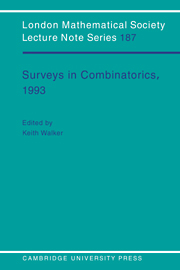Book contents
- Frontmatter
- Contents
- Preface
- Restricted colorings of graphs
- Polynomials in finite geometries and combinatorics
- Models of random partial orders
- Applications of submodular functions
- Weighted quasigroups
- Graphs with projective subconstituents which contain short cycles
- On circuit covers, circuit decompositions and Euler tours of graphs
- Slicing the hypercube
- Combinatorial designs and cryptography
On circuit covers, circuit decompositions and Euler tours of graphs
Published online by Cambridge University Press: 16 March 2010
- Frontmatter
- Contents
- Preface
- Restricted colorings of graphs
- Polynomials in finite geometries and combinatorics
- Models of random partial orders
- Applications of submodular functions
- Weighted quasigroups
- Graphs with projective subconstituents which contain short cycles
- On circuit covers, circuit decompositions and Euler tours of graphs
- Slicing the hypercube
- Combinatorial designs and cryptography
Summary
Introduction
I will review certain results and problems concerning the covering of the edge set of a graph with circuits or Euler tours. The areas I shall consider are:
Faithful circuit covers of weighted graphs.
Shortest circuit covers of bridgeless graphs.
Compatible circuit decompositions and Euler tours of Eulerian graphs.
Even circuit decompositions of Eulerian graphs.
I will describe interconnections between these areas and also indicate connections with other areas of combinatorics: matroids, isotropic systems, edge colouring of graphs, latin squares, nowhere-zero flows in graphs, and the Chinese postman problem.
Throughout this survey my graphs will be finite and without loops, although they may contain multiple edges. By a closed walk in a graph G, I will mean an alternating sequence of vertices and edges which starts and ends at the same vertex and is such that consecutive vertices and edges are incident. The length of the walk is the number of edges in the sequence. A tour is a closed walk which does not repeat edges. An Euler tour of G is a tour which traverses every edge of G. We shall say that a graph is Eulerian if it has an Euler tour. A tour decomposition of G is a partition of E(G) into (edge sets of) tours. We will consider an Euler tour of G to be a tour decomposition into exactly one tour. A circuit is a tour which does not repeat vertices, except when the first vertex is repeated as the last.
- Type
- Chapter
- Information
- Surveys in Combinatorics, 1993 , pp. 191 - 210Publisher: Cambridge University PressPrint publication year: 1993
- 4
- Cited by



